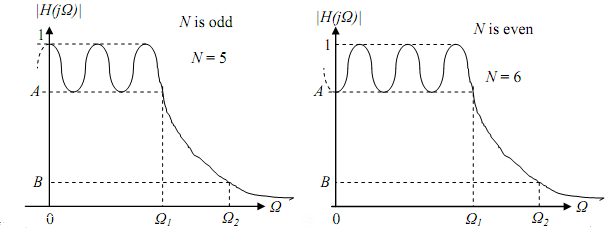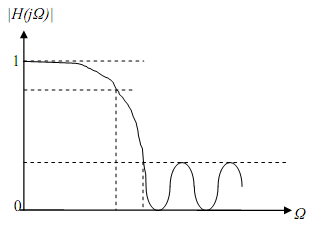The Chebyshev filter
The Butterworth filter provides a good approximation to the ideal low pass characteristics for values of Ω near zero, but has a low fall-off rate in the transition band. The Chebyshev filter has ripples in either the pass band or the stop band but has a sharper cut-off in the transition band. Thus, for filters of the same order, the Chebyshev filter has a smaller transition band than the Butterworth filter. We now look at the analog low pass Chebyshev filter. There are two types of the Chebyshev filter.
Type I (Chebyshev I) is an all-pole filter. It has equiripple nature in the pass band and monotonically decreases in the stop band. For N = order of the filter, the value response looks as below (N = 5 and N = 6 illustrated). The magnitude, |H(jΩ)|, is a symmetric function of Ω.

Type II (Chebyshev II or Inverse Chebyshev) filter has both zeros and poles. It has a monotonically decreasing shape in the pass band and an equiripple behavior in the stop band.

Email based The Chebyshev filter assignment help - The Chebyshev filter homework help at Expertsmind
Are you finding answers for The Chebyshev filter based questions? Ask The Chebyshev filter questions and get answers from qualified and experienced Digital signal processing tutors anytime from anywhere 24x7. We at www.expertsmind.com offer The Chebyshev filter assignment help -The Chebyshev filter homework help and Digital signal processing problem's solution with step by step procedure.
Why Expertsmind for Digital signal processing assignment help service
1. higher degree holder and experienced tutors
2. Punctuality and responsibility of work
3. Quality solution with 100% plagiarism free answers
4. On Time Delivery
5. Privacy of information and details
6. Excellence in solving Digital signal processing queries in excels and word format.
7. Best tutoring assistance 24x7 hours